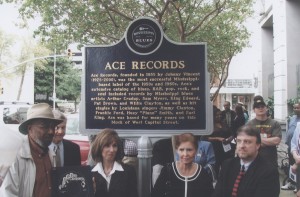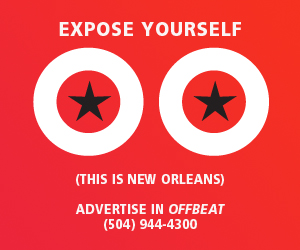I wonder why there’s such an overall lack of appreciation for musical legends in New Orleans, which is the most musical city on earth. There’s such a deep love for our musical culture—not necessarily shared by the majority of the population of this city and state—that it seems a shame that we’re not honoring the places and people who created the music.
One easy way to do this that’s certainly fairly economical in cost is to put plaques on the important places in New Orleans and Louisiana musical history.
I thought of this early today on my way to work, as I passed the bar on Elysian Fields that used to be Charlene’s. When Charlene Schneider passed away, her patrons and friends erected a plaque to her memory on the side of the bar. I’d never seen the plaque before, but I thought it was something that was very thoughtful and let everyone know how great a person Charlene was, and how important she was to the community. At the office today, there was a new book waiting for review. The book is about Donald Harrison, Sr. (Big Chief Harrison and the Mardi Gras Indians), authored by Al Kennedy, a well-respected New Orleans historian, writer and university professor. I thumbed through the book and found the photo section, as is contained in a lot of biographies, and came across a photo of the house on Jackson Avenue where Donald Harrison grew up. Without going into a lot of detail (read the book!), suffice it to say that Big Chief Harrison was a “magnificent American hero” whose involvement in the Mardi Gras Indian culture and music needs to be memorialized, along with so many others.
Some plaques have been erected through the efforts of private groups like the Preservation Resource Center. There’s construction going on in Armstrong Park that will also contain some status of local musical heroes, like fellow Mardi Gras Indian Big Chief Tootie Montana, Mahalia Jackson, trumpeter Buddy Bolden, brass bands, the old French Opera House and Congo Square. There’s a Musical Legends Park on Bourbon Street with memorial statues of Al Hirt, Pete Fountain, Ronnie Kole, Fats Domino and Chris Owens. Cosimo Matassa’s J&M Studio location on North Rampart Street has a plaque (too bad it’s now a laundromat with nothing inside to memorialize the great work that came out of that studio). The New Orleans Jazz Historical Park gives regular tours of the city’s music places.  That’s a start.
That’s a start.
At one time the state of Louisiana had a “Music Trail,” an idea which is probably a pretty good one (it no longer exists in Louisiana – duh), although the state of Mississippi has one, and Alabama sort of does too. A reader sent me a photo he’d taken when a music marker was placed commemorating Ace Records. If you look closely at the photograph, you’ll see the names of Louisiana artists mentioned as well: Jimmy Clanton, Huey “Piano” Smith, Frankie Ford and Earl King.
We need more emphasis from tourism people in New Orleans and around the state to preserve and promote these sites that are interesting, attractive to locals (especially students) and visitors and are so important to our musical culture. Perhaps it should be a collaborative effort between the cities’ and states’ tourism offices and CVBs and the preservation groups in each area. And, most importantly, all efforts need to be coordinated and marketed and promoted.




